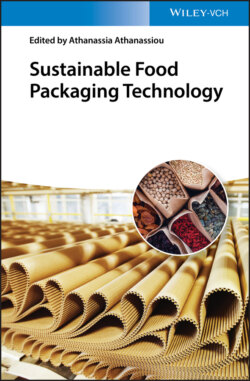Читать книгу Sustainable Food Packaging Technology - Группа авторов - Страница 37
2.2.2 Preparation and Characterization of Fish Gelatin Films and Coatings
ОглавлениеIn order to prepare fish gelatin coatings, solutions can be applied onto food surfaces using different techniques, such as dipping, spraying, brushing, or panning [57], dipping and spraying being the most employed on fish, dairy products, or minimally‐processed fruit and vegetables. Abdelhedi et al. [58] evaluated the quality of fresh fish fillet samples immersed into different gelatin solutions. Indeed, samples dipped into black barred halfbeak (Hemiramphus far) gelatin solution were more efficient than samples coated with commercial bovine gelatin, and the effect was improved by the addition of its hydrolysate.
Considering gelatin has excellent film‐forming capacity, fish gelatin films are often prepared via solution casting for food packaging applications [59]. The process starts with dissolving gelatin along with additives, such as plasticizers or active compounds, in a suitable solvent, usually water or water–alcohol solutions. Heating and/or pH changes alter solution conditions, which affect the final properties of the film. Then, the solution is cast and, finally, solvent evaporation takes place when solutions are subjected to drying processes, leading to film formation [60]. Solution casting is widely used at laboratory scale owing to its simplicity [61, 62]. However, dry methods, such as compression molding [63] and extrusion [64], have also been used [65]. These methods are larger production techniques, faster, and more appropriate for industrial scale production since the pre‐existing technology used in the plastic industry can be used for gelatin film production.
In order to assess the suitability of films for food packaging, their properties must be evaluated. The mechanical behavior of films is an important issue, since films intended for food packaging require both resistance and flexibility to facilitate handling and to avoid breaking during packaging, transport, and storage stages [66]. Thus, plasticizers are commonly added to reduce hydrogen bonding and increase the molecular spacing between protein chains [67]. Due to its small size and hydrophilic nature, glycerol is a compatible plasticizer with fish gelatin and it has been widely used for gelatins [68–70]. However, the incorporation of more hydrophobic additives, such as fatty acids, may increase water resistance of fish gelatin films [71]. Physical, chemical, and enzymatic cross‐linking have also been explored to reduce water sensitivity of gelatin [65]. In particular, the addition of glucose to promote the chemical cross‐linking with amino groups of gelatin, known as Maillard reaction, reduces water solubility and increases water contact angle of fish gelatin films [72]. Furthermore, barrier properties against UV light are improved with Maillard reaction, even if fish gelatin shows high absorption of UV light in the range of 200–300 nm due to the presence of peptide and aromatic amino acid residues [73]. In addition to UV light barrier properties, fish gelatin can provide materials with good oxygen barrier properties, preventing food oxidation and extending food shelf life [74].
In terms of optical properties, film and coating appearance (color, transparency, and gloss) is directly related to consumer acceptability. Films and coatings based on fish gelatin are usually transparent and colorless [75]. Nevertheless, the incorporation of additives into the formulations to improve functional properties can affect the film transparency [76]. For instance, the presence of zinc oxide leads to a whitening effect [77]. Also cross‐linking reactions, such as Maillard reaction, produce a browning effect [78]. Regarding gloss, this property is related to the surface morphology [79]. Fish gelatin films showed lower gloss values when cross‐linked with citric acid, indicating the formation of a rougher surface as a consequence of the cross‐linking reaction [80]. It is worth noting that rougher surfaces provide more convenient properties to print the film for commercial purposes.
In addition to film characterization, other issues, such as contamination of food by migration of additives, are relevant matters due to potential health‐related risks [81]. Thus, even if fish gelatin is classified as Generally Recognized As Safe (GRAS) polymer by the Food and Drug Administration (FDA) center for food safety and nutrition, fish gelatin‐based materials intended for the packaging of foodstuffs must be approved after assessing the absence of toxic effects to the consumer and organoleptic changes to the food. Furthermore, the assessment of food quality can give detailed information of film and coating suitability. For instance, one of the most widely used means for the evaluation of fish quality, total volatile bases nitrogen (TVBN), is the key index of fish freshness [82, 83].
